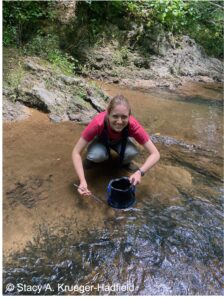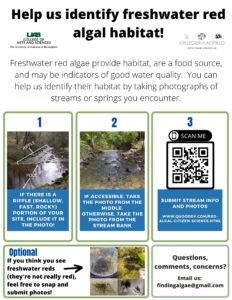
About the blog author: Sarah Shainker Connelly (@SarahShainker) wrote this post as part of Dr. Stacy Krueger-Hadfield’s Scientific Communication course at the University of Alabama at Birmingham. She completed a B.S. in Marine Biology at the College of Charleston before serving as a Peace Corps volunteer in the Philippines in Coastal Resource Management. Sarah is now a third-year PhD candidate in the Krueger-Hadfield lab at the University of Alabama at Birmingham. She plans to integrate population genetics, ecology, and a citizen science monitoring network to better understand the evolutionary ecology of freshwater macroalgae in the eastern United States.
As a kid, I imagined that scientists travelled to far-away places – like the Amazon or even outer space – to conduct their research. I did not think that there were still any undiscovered or under-studied species in my own backyard. I doubt I am the only one who has viewed science this way, and unfortunately, this perspective makes science seem like an exclusive club. If we think science only happens in exotic, far-away places, then it is only available to the select few that have the money and time to access those places. Which communities benefit from this “exclusive” knowledge, and which are left out?
As I have progressed in my education, I have been astonished by how much remains to be discovered, especially in the ecosystems that I thought I knew so well! My dissertation research focuses on the evolutionary ecology of freshwater red algae (Fig. 1) within the incredibly biodiverse streams of the southeastern U.S. (Master et al., 1998). The streams I study as a PhD student are not that different from the one in the backyard of my childhood home.

We can promote a more inclusive view of science by involving the public in local research. Citizen science is one way to connect the public to science, conveniently in their own backyard, by providing opportunities for amateur scientists to contribute to real research. Any citizen of the world can participate – you do not have to be a citizen of any particular country. For example, snow algae are microscopic organisms that create pink patches of snow when they bloom. The Living Snow Project engages the outdoor recreation community in sampling these algae. The data collected by these amateur scientists expand the scientific community’s knowledge of when and where these algae are found, which could potentially help us understand how climate change will affect these really important microbes in snowy habitats.
Well-designed citizen science projects create a forum in which participants can engage in scientific thinking (Trumbull et al., 2000) and may increase the value they assign to the ecology of their own backyards (Evans et al., 2005). This creates a foundation in scientific literacy that in turn promotes the development of environmental policies and conservation plans (Brewer, 2002; Trumbull et al., 2000).
How do freshwater red algae fit into this? I’m interested in their complex life cycles and how that intersects with their reproductive systems. Freshwater red algae provide food and habitat for macroinvertebrates (Hambrook & Sheath, 1987; Sheath et al., 1995, ). They may even be useful bioindicators as they tend to only occur in streams with high water quality (Stancheva & Sheath, 2016). However, before we can do anything fancy, from evolution to policy, we need to know where freshwater red algae can be found.
To identify sites, we are initiating a citizen science macroalgal monitoring program. This project will expand our lab’s monitoring capacity and aid us in identifying accessible sites for sampling. All this work has the added benefit of enhancing our knowledge about Alabama’s freshwater biodiversity, both within the scientific community and the local community.

In the spring, I spoke to a group of volunteer water monitors with the Alabama Water Watch. AWW trains volunteers to monitor water quality throughout the state and encourages them to use their data to educate others and advocate for water policy.
We have asked volunteers to take and submit photographs of the streams they encounter (Fig. 2). Then, we can determine likely candidates for sampling from these photos based on physical features that may indicate the presence of algae. Within the next year, we plan to train volunteers to sample the algae. We are excited by the interest and curiosity volunteers have shown so far and are excited to see what we learn together!
Anyone can contribute to this project – whether or not you are a volunteer water monitor! If you would like to get involved, see our web page for instructions and contact information.
References
Hambrook, J. A., & Sheath, R. G. (1987). Grazing of Freshwater Rhodophyta. J. Phycol., 23, 656–662.



